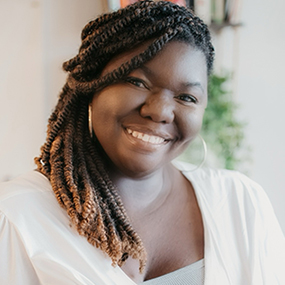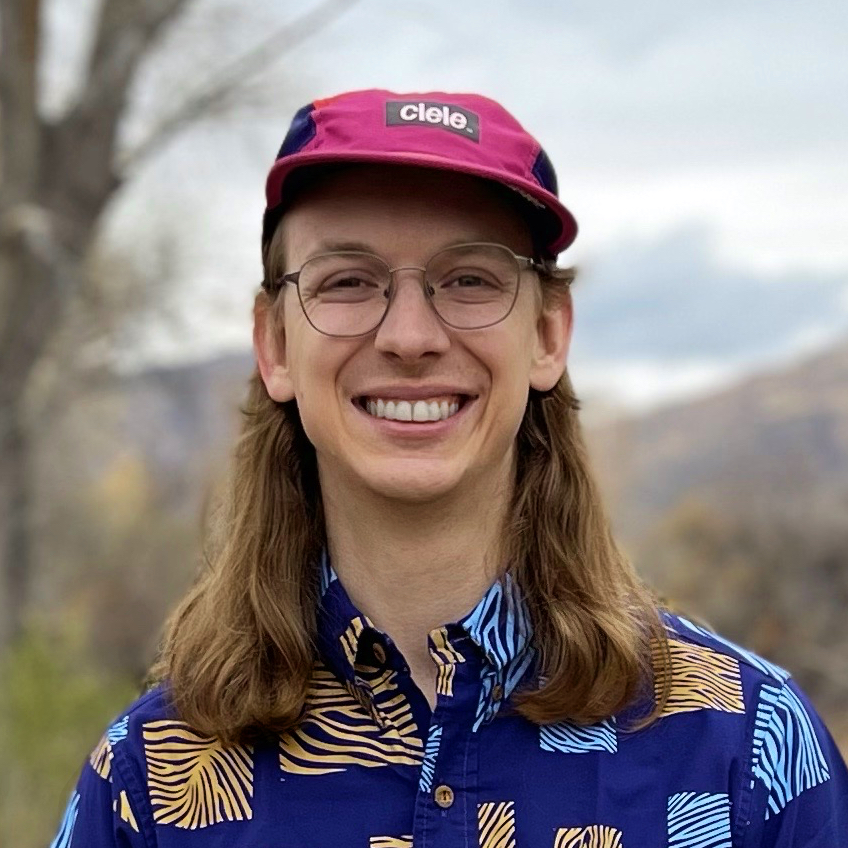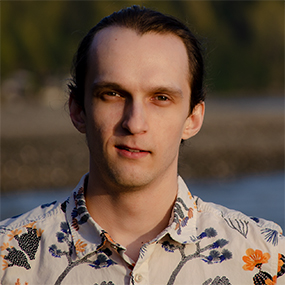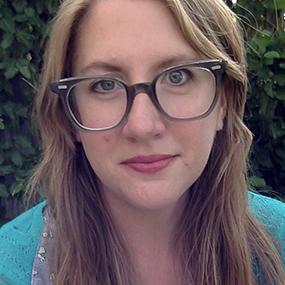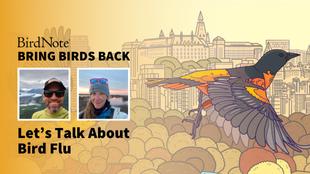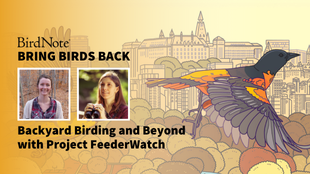

Join BirdNote tomorrow, November 30th!
Illustrator David Sibley and actor H. Jon Benjamin will face off in the bird illustration battle of the century during BirdNote's Year-end Celebration and Auction!
People with disabilities often face barriers to birding. These can be infrastructural and cultural. The organization Birdability is addressing those barriers by raising awareness, crowdsourcing information on what trails and birding spots are already accessible (or what other locations need to do to improve), advocating for these changes, and building community for disabled people in birding. Tenijah travels to Wheeler National Wildlife Refuge in Alabama to go birding and learns how to make nature more accessible with Freya McGregor (former coordinator of Birdability) and birders BJ Allen, Linda Neighbors, and Hal Tichenor.
Tenijah Hamilton: BirdNote Presents
[Echoing Wingflap SFX]
Freya McGregor: Birding is for everybody. That's sort of our tagline, like not just birding is for everyone, birding is for everybody. Every kind of body. And disability is just part of our variation. Everybody benefits from accessibility. Everybody benefits from feeling welcome and included. I want to be birding when I'm 95. I'm probably not going to be as like, fit and agile as I am now. So, you know, this is a conversation that's about all of us.
[Gentle, inquisitive music begins]
Tenijah Hamilton: This is Bring Birds Back. I'm Tenijah Hamilton. And this season, one of the big things I've been looking at is finding community in the outdoors. That's what led me to Birdability, a new organization centered around making birding more accessible to birders with disabilities. According to the CDC, 1 in 4 Americans has a disability.
Freya McGregor is the coordinator of Birdabilty. The organization is all about addressing something Freya calls “access needs” for people with disabilities:
Freya McGregor: Everyone has access needs. To get to a third story on a building, I need stairs or an elevator. I can't just fly. That's an access need. But for non-disabled people these needs are generally just met. When talking about people with disabilities and other health concerns, very often, these access needs are not just defaultly met.
Tenijah Hamilton: She says that even something as simple as the language we use around birding can exclude people with disabilities — going for a "bird walk" implies people in wheelchairs can't be a part of it, even if that's not the case. Freya has a background in occupational therapy specializing in blindness and low-vision services, so she brings that perspective to her work too.
Freya McGregor: Many people talk about bird watching,
Tenijah Hamilton: Ah, yes.
Freya McGregor: and it's really obvious to me that you don't have to see birds to enjoy them. Most sighted birders bird by ear to some extent. Even if it's just, “Oh, I can hear a noise, let me go look for it.”
Tenijah Hamilton: There is no one "right" way to love and appreciate birds. There are so many ways to engage with nature. Similarly, there's no single way for disability to look. Disability is really diverse:
Freya McGregor: People who are blind or have low vision have different access needs than someone who is using a power wheelchair. A power wheelchair user has different access needs than someone using a manual wheelchair. Someone who is autistic, who has sensory sensitivities, combat veterans with PTSD, like you’re going to have different needs than someone who has chronic fatigue.
[Inquisitive music fades out]
Tenijah Hamilton: Birdability is working with people all across that spectrum of disability to move things forward. Now, there isn't time on a 30 minute episode to dive deep into birding access needs for every disability, so today we're going to focus on birders in wheelchairs or with motor disabilities.
[Gentle outside SFX fade up]
Tenijah Hamilton: Back in March, I traveled to Wheeler National Wildlife Refuge in north Alabama to meet up with Freya and some avid birders with ambulatory disabilities.
Tenijah Hamilton: How are y'all?
Linda Neighbors: Good.
Tenijah Hamilton: I'm Tenijah.
Linda Neighbors: Hey Tenijah!
Tenijah Hamilton: There's Linda Neighbors, she uses a manual wheelchair. Hal Tichnor, he uses a power wheelchair. And BJ Allen, who was using a wheeled walker.
Tenijah Hamilton: Nice to meet you all!
Tenijah Hamilton: As we started along the trail, BJ told me all about how she first got into birding:
[Sounds of BJ’s wheeled walker rolling along the gravel trail audible throughout]
BJ Allen: A friend of mine many, many years ago, back in the eighties, she had put up some bird feeders in her yard and she was getting birds that she didn't know what they were, and that she had seen this special studies class to teach about birds. And so she thought, I wanna do that, but it'd be nicer if I could do it with somebody. So she asked me and I said, sure. And we're both still birding.
Tenijah Hamilton: Wow.
In any of the classes you took, did they kind of talk about accessibility in birding?
BJ Allen: It was never mentioned. And most of the class was elderly people.
Tenijah Hamilton: That’s unfortunate.
BJ Allen: A lot of them didn't participate in some of the field trips because of it.
Tenijah Hamilton: We got to the end of the trail, to a really fancy observation booth. It's like the glamping version of a bird blind. Basically a little cabin with floor to ceiling windows where you could watch the birds more easily without them noticing you.
[Observation booth doors click shut; outdoor sound mostly disappears inside the somewhat echoey building]
Tenijah Hamilton: This is gorgeous!
Freya McGregor: Yeah so we really love this observation building because some bird blinds will have windows that you peer out of, and they're often not at the height of a seated person or a shorter person, but the windows here are from like a foot off the ground. Right up high. So everyone can see out no matter where they're sitting, no matter where their eye-line is, which is really cool. The other thing that's cool is because they have the microphones on the outside of the building and then there's speakers on the inside so that we can hear the noise the birds are making. The volume is up, so people who are hard of hearing might have more chance of hearing that sound from inside than they would from outside. That's really cool.
[Relaxed, playful music enters]
Tenijah Hamilton: We spent a while in the observation room, watching a pair of Wood Ducks...
BJ Allen: They're so pretty. To me they're one of God's masterpieces. He's got white lines around all of his colors.
Tenijah Hamilton: We debated if we were seeing Greater or Lesser Yellowlegs...
Freya McGregor: They look really, really similar. So, what's the consensus, they're lesser?
Linda Neighbors (farther away): I think they're lesser. In what I read, the lesser has a very straight bill and the greater has an upturned bill…
Tenijah Hamilton: We saw an Osprey, shovelers, a Bald Eagle plucking a fish from the water — y'all, I was living my best life.
[Playful music ends]
Tenijah Hamilton: While we were taking joy in all these birds and talking about the space, a park ranger Freya knew stopped by…
Freya McGregor (farther away): He’s a ranger!
Dave Young: …not in uniform.
[laughter from group]
Tenijah Hamilton: His name is Dave Young, and he helps manage the birding facilities for the Refuge. He was excited to talk to us and to hear from Freya about what was and wasn’t working about the infrastructure, and how it could be improved. And, while this building is above-average, Freya still saw a number of places that it fell short.
Freya McGregor: One thing that would be great for them to adjust in this viewing area though, they have like bleachers for people to sit on, which is lovely. People who want to rest. That's great. But it doesn't leave a lot of circulation space for mobility devices to get in and move around and not crash into people. So having a bit more circulation space is really valuable. Hal here in his powered wheelchair, it was tricky for him to get in and out around this corner. The air conditioning unit thing that's taking up floor space could be maybe mounted on a wall or something out of the floor space. Would have made his life a little bit easier.
Dave Young: It's helpful to have feedback from visitors, suggestions. Even if they're small, I think a lot of times we overlook those things cause it's not our lived experience.
[Speaking towards the rest of the group] Did you guys have any other comments on the space?
Tenijah Hamilton: For Hal, something immediately came to mind:
Hal Tichnor: If you could pave that path out there, that would be great.
Freya McGregor: What, what is it about the crushed granite that is difficult in a powered wheelchair?
Hal Tichnor: It, uh, it just feels very uncomfortable on the lower back.
Dave Young: It was actually in our original plans of renovations, um, then it became a cost factor. It got pulled out. But it is on our radar. Even if we can't act on it right away, it's something that's, the wheels are turning. The thought is in the back of the head for when, when the opportunity comes up…
[Sounds of the observation booth slowly fade]
Tenijah Hamilton: Freya spends a lot of time on things like this — working with facilities managers and communicating how birding spaces can be made more accessible. And that's just one part of what Birdability does. Birdability also seeks to “empower a welcoming and inclusive birding community”
Freya McGregor: That idea is about trying to modify this, the social, the cultural and the institutional environments of birding, because if they don't support it, it doesn't matter how beautiful that trail is, how accessible it is. If everyone using it is obnoxious or racist or the bird club isn't being inclusive, you know, like people with access challenges in particular aren't going to go do the thing.
Tenijah Hamilton: And the third goal of Birdability is actively inviting people with disabilities to join the birding world.
Freya McGregor: It's not just enough to go, oh, well, we've built it. They should come. Like you've gotta be intentional. Like, we, we really want you here. Like, come join us.
Tenijah Hamilton: This was a huge part of BJ Allen’s story — BJ had been on the Alabama birding scene for over 30 years. She was the first paid employee of Birmingham Audubon and served a term as President of the Alabama Ornithological Society. But then, in 2020, she was in a head-on car collision. And she wasn't able to go birding.
[Sound of BJ’s wheeled walker and footsteps on gravel fade in]
BJ Allen: After my accident, I just felt like I would never feel normal until I could go out and bird again.
[Somber music begins, soloed for a few beats]
Tenijah Hamilton: Even as she recovered, BJ was nervous to try birding again — what if she traveled a long way and she couldn't use the trail, or if someone judged her? But then a friend invited her to an event with Birdability that was just over the hill from BJ.
BJ Allen: And I thought, well, I could go and try. And if it doesn't work, I can just turn around and go home. And that's where I met Freya and everything. And it was really nice. I mean, you don't feel like you're sticking out like a sore thumb. And just — seeing all my birding friends and everything. It was — that was — I felt like, okay, things are going to get somewhat back to normal one of these days.
Tenijah Hamilton: So this was kind of the activity that made you kind of like— it felt like getting back out there. You felt like yourself?
BJ Allen: Oh yes, definitely. I feel like a member of the human race again.
Tenijah Hamilton: How come? What is it about birding?
BJ Allen: Just observing nature and seeing how everything fits together. And it's a big way for me to realize, a higher power is definitely in charge because we could have never figured this out.
[Both laugh happily]
[Music becomes more optimistic, joyful; soloed for a few beats]
Tenijah Hamilton: After the break, we continue to explore Wheeler National Wildlife Refuge, talk about empowering folks with disabilities to be able to bird on their terms, and the biggest obstacles to making our birding spaces more accessible. Be right back.
[Music fades out]
[MIDROLL AD BREAK]
[Sounds of Wheeler National Wildlife Refuge fade in; slight breeze shaking trees]
Tenijah Hamilton: And we're back, exploring more of Wheeler National Wildlife Refuge.
Linda Neighbors: There's somebody out there, but he's in that thicket. Or she, as the case may be. It's in the thickets though. Who knows.
BJ Allen: Do you see it?
Tenijah Hamilton: I see something… nope. It's a branch.
[Group laughter]
BJ Allen: Leaf birds, rock birds.
Linda Neighbors: In the fall the leaf birds are the worst.
[Sound of footsteps and wheels moving along the gravel trail]
Tenijah Hamilton: We did actually see a lot more birds! And I even learned some new names. Like, BJ taught me the delightful nickname for Yellow-rumped Warblers: Butter Butt!
BJ Allen: Because if you look right on the end where their tail meets their body, remember when butter was served in little pats. Little squares. It looks like somebody placed one of those right on their rump.
Freya McGregor: Like it’s yellow.
BJ Allen: And it's easier to say than Yellow-rumped Warbler.
[Sound of footsteps and wheels moving along the gravel trail]
Tenijah Hamilton: Something that both surprised and inspired me is how much people within the disability community are learning from each other, from their differences. Like, Linda Neighbors has been on the field trip committee for Alabama Audubon for about five years, pushing for more accessible trips:
Linda Neighbors: So it's like, okay, I really want us to start to let people know if they look at our field trips, which field trips are accessible.
Tenijah Hamilton: Yeah.
Linda Neighbors: And how are they accessible? You know, is it wheelchair accessible? Is it just, it's easy walking or, you know, more. And Freya’s been so great as far as, I guess, bringing my awareness up, as far as accessibility.
Tenijah Hamilton: Like what?
Linda Neighbors: Well — vision. I don't think of low vision folks as being birders, but they're probably a lot better birders than I am because they bird by ear so much. People want to be as independent as the other person is. And so it's just, being aware of those limitations that people have that are not obvious, whether it's hearing or vision or you know, maybe something like autism or some of the more silent issues that people have.
[Sounds of trails fades out]
Tenijah Hamilton: Building community and bringing birders with disabilities together is of course a huge priority for Birdability. But so is empowering people to bird independently.
Freya McGregor: Like if you want to be doing this by yourself— you know, being outside in the woods or by a lake or somewhere by yourself, like that has so much power that is very different than being there with a friend or a group.
Tenijah Hamilton: And to help birders with disabilities go solo if they want to, Birdability has created the Birdability Map in partnership with the National Audubon Society. There's a really detailed checklist for evaluating parks and trails — and anyone can help contribute to this map, so birders with different access needs can know if it's a place worth going for them.
Freya McGregor: It's not an assessment. It's not designed to like give you a score or anything. Just tell us what's there. Are there benches? Do they have armrests? What's the surface of the trail? Is it concrete or is it gravel or is it a mixture of both? And that detailed information is really important for a lot of different people to know if that's a place that, you know, it's worth driving two hours for
Tenijah Hamilton: Right!
Freya McGregor: or not.
Tenijah Hamilton: Now, in an ideal world, way more places would check all the boxes, and be super accessible spaces. So what's standing in the way of that?
One challenge is that some birders have opposed accessibility improvements like paving a trail, worrying that the construction would be detrimental to the birds. But there are answers to these concerns — construction could be done outside of the migration season to have the lowest impact on birds. And some researchers have been looking into how paved paths might actually protect ecosystems in some cases by promoting more people to stay on the trail. And it's not like Birdability wants every trail to be paved:
Freya McGregor: We're not trying to have, you know, concrete trails up Mount Everest. Like that would be bizarre, and impossible. But, you know, we're not trying to say like every trail in the world needs to be, you know, 0% gradient and 62 inches wide. But the places that could be accessible, but aren't really quite there yet — those are the ones we would like to see.
Tenijah Hamilton: Another big obstacle to creating more accessible nature spaces is money. But the thing is, it’s always going to be less expensive to include accessibility from the beginning, versus trying to tack it on later with renovations — that’s when it can get really expensive. It’s better to invest that money up front.
And maybe the biggest challenge is that people designing and building these spaces and trails don't know what people with disabilities need. That's an information gap Birdability wants to fix.
Freya McGregor: There hasn't been a really detailed, thorough resource about accessibility for site managers, and so on, to reference when they're designing trails. And so they don't know this stuff. And that's something we're trying to address. We have a lot of information on our website about, like, what this access feature is and who it's for and why this is important.
[Sound of footsteps and wheels moving along the gravel trail fades in]
Tenijah Hamilton: As we continued down the trail we passed by a bench off to the side.
Freya McGregor: Here's a great example of a bench that's not quite as good as it could be. So we love armrests because they help people transfer from sitting to standing.
Linda Neighbors: That's for sure.
Freya McGregor: This bench, it is on the same surface that the trail is, but there's a wood edging to the trail that you have to drop off to get to the bench. And so, for example, perhaps BJ with her walking frame, that could be a real challenge, even though she really wants to sit down. She's going to have to get up another inch to get back on the trail.
Tenijah Hamilton: And then, like 50 feet further down the trail, we passed another bench. Except...
Freya McGregor: See how it's smooth. There's no plank of wood that changes the trail. So there's not the same potential barrier that there is back there.
Tenijah Hamilton: It seemed odd to me — why were these so different? Dave told me that this was a planning thing. See, a lot of times, things like benches at wildlife refuges and parks will be built as Eagle Scout projects or as work from different nonprofits, so the processes aren't connected.
[Wind in trees picks up]
Dave Young: And so I'm guessing this was one person's project where another bench might have been a scouting project.
Tenijah Hamilton: Yeah.
Dave Young: And there wasn't that discussion ahead of time about that detail.
Freya McGregor: Sure.
Dave Young: There probably was at the time of this construction. And maybe something where like, you know, if a facility manager has, like, a contact they can go to if they have an Eagle Scout that wants to build something, say, “Hey, can we send this to somebody that can just look it over and point out anything that might need to be changed ahead of time?” I think that's a really great resource for somebody building those things.
Freya McGregor (cutting Dave off): It's called the Birdability website!
Dave Young: It's called the Birdability website. [Group Laughter] I will share that with my colleagues.
[Sound of refuge fade out]
Tenijah Hamilton: Dave’s humility, willingness to learn and genuine appreciation for feedback was really wonderful to see — and that's something we can all do to make birding a more welcoming and inclusive space. Freya has so many ways for people to get involved:
Freya McGregor: We have strategies on our website about being a more welcoming and inclusive birder. Read them. Do them. Try. Think about this stuff. Advocate to your bird club or your Audubon chapter or your local state park for ways that as organizations, they can be more inclusive. There's ideas all over our website about that too. Advocating for your local birding group to be holding regular accessible bird outings, you know? Reaching out to folks saying, "Hey, do you want to come? Like, we'd love you to come along. What do you need from us so that you're able to participate?" There's lots of things to do, but start somewhere. Cause that's how we get places.
[Sweet, hopeful music enters]
Tenijah Hamilton: As I traveled home from Wheeler National Wildlife Refuge, what I kept thinking about were the moments of pure joy — of birders having a good time, sharing in each others’ company, delighting in our feathered friends. That's a feeling we all should be able to have.
BJ Allen: Look at these guys, bouncing, bouncing, bouncing. They just make it look so easy to swim and fly.
Linda Neighbors: It is for them. It is for them. They’re geese.
[Both laugh]
BJ Allen: I know.
Linda Neighbors: They look at us and say, look how easy they make it look to stand up on two feet and just walk around.
[Music solo for a few beats]
Tenijah Hamilton: Bring Birds Back is produced by Mark Bramhill and me, Tenijah Hamilton. Sam Johnson is our production assistant. We're edited by Allison Behringer and Oluwakemi Aladesuyi of Rough Cut Collective. Our fact checker is Conor Gearin. Our Content Director is Allison Wilson. Scoring is by Cosmo Sheldrake and Blue Dot Sessions. Special thanks to Rehka Murthy.
[Music ends]
######################
MUSIC:
“Are We Loose Yet”, “Gentle Son”, and “Lost Sage” by Blue Dot Sessions
“Nightingale Part 2” by Cosmo Sheldrake
About guest Freya McGregor:
Freya McGregor (she/her), OTR/L, CIG is Birdability’s former Director of Programs and Outreach, and an occupational therapist. Birding since childhood, her ‘dodgy’ knee often creates an accessibility challenge for her. With a clinical background in blindness and low vision services, she works in her spare time for the radio show and podcast Talkin’ Birds, and writes about inclusion, access, disability, and birding, most recently in the LA Times. She is on a mission to redefine 'birding' as 'the act of enjoying wild birds', and is passionate about enabling all birders and potential future birders to enjoy birding and nature as much as she does. Learn more about birdability at birdability.org or follow @birdability on social media, and join in Freya's adventures @the.ot.birder on Instagram.
About guest Linda Neighbors:
Linda Neighbors is a semi-retired Physical Therapist. She enjoys birding and is currently the chairperson for the field trip committee of Alabama Audubon. Due to an incomplete spinal cord injury in conjunction with arthritic knees she finds birding from her wheelchair much easier and more enjoyable.
About guest BJ Allen:
BJ Allen started birding when she started taking Birdwatching classes at UAB Special Studies. The classes included field trips so I made friends in the birding world. She served as the President of the Alabama Ornithological Society and was the first paid employee of the Birmingham Audubon Society (after retiring from a 40 yr career in telecommunications. She was injured in an auto accident April 2020 and now has to use a cane or rollator to get around which makes it difficult to do much birding. She was thrilled to learn of Birdability and have participated in some of their bird walks.
About guest David Young:
David has worked as a park ranger at several national parks and national wildlife refuges across the United States and currently serves as a Visitor Services Park Ranger for the US Fish and Wildlife Service at Wheeler National Wildlife Refuge in Decatur, AL. The 35,000 acres refuge provides habitat for various species of wildlife, including wintering habitat to a large wintering population of ducks, geese, and cranes and provides wildlife-dependent recreational opportunities, including birding, at locations throughout the refuge. Many of the best birding sites on the refuge, including the wildlife observation building, are stops along the North Alabama Birding Trail.


